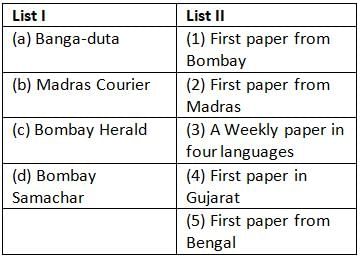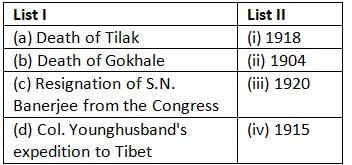Spectrum Test: The Freedom Struggle- 2 - UPSC MCQ
30 Questions MCQ Test History for UPSC CSE - Spectrum Test: The Freedom Struggle- 2
Arrange the following organisations in chronological order:
(1) East India Association in London
(2) Landholders’ Society at Calcutta
(3) Madras Native Association
(4) Bengal British Indian Society
(5) British Indian Association
Choose the answer from the codes given below:
Arrange the following events in the correct chronological order:
(1) Repeal of the Vernacular Press Act.
(2) Appointment of the first Famine Commission
(3) Passing of the Ilbert Bill
(4) Passing of the first Indian Factory Act
Select the answer from the codes given below:
Match List-I with List-II and select the answer from the codes given below the lists:
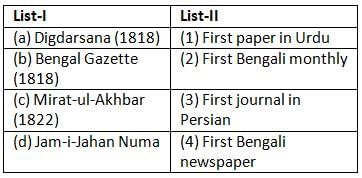
Codes

Codes
Which code gives the correct matching of the following lists?
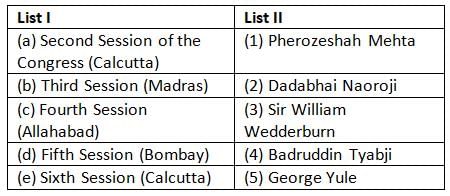
Codes:
Match List-I with List-II and choose the answer from the codes given below the lists:
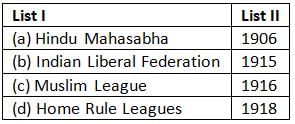
Codes:
Which of the following statements is/are not true about the Non-Cooperation and Khilafat Movement?
(i) At the Vijayawada session of the AICC (April, 1921), the “Tilak Swaraj Fund” was started to finance the Non-Cooperation Movement.
(ii) At the same session, it was decided to enroll one crore members in the Congress by the end of June 1921.
(iii) At the Karachi Khilafat Conference in July 1921 the Ali brothers called on the Muslims to resign from the army, and hence they were jailed by the British in November, 1921.
(iv) Some Khilafat members like Hasrat Mohani began demanding complete independence by the end of 1921.
(v) The Jamia Millia Islamia was started in Delhi in 1921.
Select the answer from the codes given below:
Which of the following clauses was/were not included in the Gandhi-Irwin Pact?
(i) Withdrawing all ordinances and ending prosecutions;
(ii) Release of all kinds of political prisoners;
(iii) Restoration of the confiscated property of the Satyagrahis;
(iv) Permitting peaceful picketing of liquor, opium and foreign cloth shops;
(v) Permitting all the Indians to collect or manufacture salt, free of duty.
Choose the answer from the codes given below:
Consider List I and List II:

Which of the above are incorrectly matched & Choose the naswer from the codes below:
Match List I and List II and select the answer from the codes given below the lists:
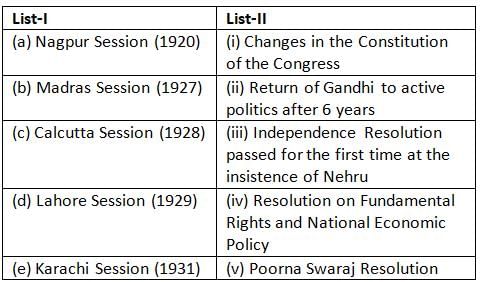
Codes:
Arrange the following in the historical sequence:
(i) Escape of Subhas Chandra Bose from India;
(ii) Celebration of the “Deliverance Day” by the Muslim League;
(iii) Resignation of the Congress Ministries;
(iv) Lahore Resolution of the League demanding separate state for Muslims;
(v) “Quit India” Resolution by the Congress
Choose the correct answer from the codes below:
Which is the correct chronological order of the following events?
(i) Simla Conference
(ii) Formation of the Azad Hind Government at Singapore by S.C. Bose
(iii) Gandhi-Jinnah Talks
(iv) Naval Mutiny
(v) INA TrialsChoose the answer from the codes given below the lists:
Which is the correct sequence of the following events?
(i) Formation of the Interim Government by the Congress;
(ii) Cabinet Mission;
(iii) Direct Action Day by the Muslim League;
(iv) Recall of Lord Wavell and appointment of Lord Mountabatten as the Viceroy
(v) Joining of the League in the Interin Government.
Select the answer from the codes below:
Arrange the following in the chronological order:
(i) Sadler Commission
(ii) Raleigh Commission
(iii) Wood’s Despatch
(iv) Hunter Commission
Choose the correct answer from the codes given below:
“Reserved Subjects” under the Dyarchy in the provinces were administered by the Governor and his Executive council. Which of the following were included in them?
(i) Law and order
(ii) Land Revenue
(iii) Agriculture
(iv) Education
(v) Industries
(vi) Irrigation
Select the answer from the codes below:
In which of the following provinces was ‘Bicameralism’ introduced for the first time in 1935?
(i) Bengal
(ii) Punjab
(iii) U.P.
(iv) Bihar
(v) Central provinces
(vi) Assam
Choose the correct answer from the codes below:
Match List I with List II and select the answer from the codes given below the lists:

Codes:
Find out the correct pairing of the following lists from the codes given below the lists:
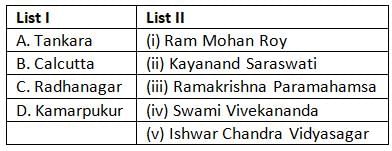
Codes:
Which code gives the correct pairing of the following lists?
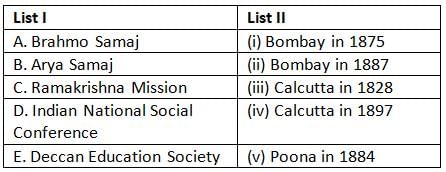
Codes:
Match List I with List II and select the correct answer using the codes given below the lists:
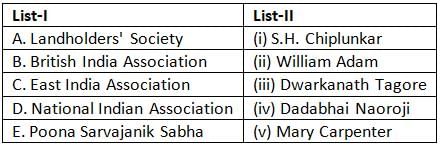
Codes:
What factors were responsible for the emergence of a common national outlook in India in the last quarter of the 19th century?
There were some immediate factors that led to the birth of the Indian National Congress in 1885. Which of the following was not one such factor?
Which British viceroy helped intensify discontent against foreign rule by the early 1880’s?
Racial bitterness of the British was clearly seen in the passing of the Vernacular Press Act which gagged public opinion in India. This Act was passed in
Indians realized that the British wanted to monopolize the higher grades of services in the administration when the government reduced the maximum age limit for sitting in the l.C.S. examination from 21 years to 19 in
The llbert Bill controversy came up during the viceroyalty of
The earliest public association in modern India was the Landholders’ Society founded in
Which statements about Birsa Munda are correct?
1. Birsa Munda led a significant tribal uprising against British authorities.
2. He promoted religious reform among the Munda people.
3. The movement aimed to reclaim the land from British authorities.
4. Birsa Munda's movement was entirely non-violent.
|
210 videos|855 docs|219 tests
|



